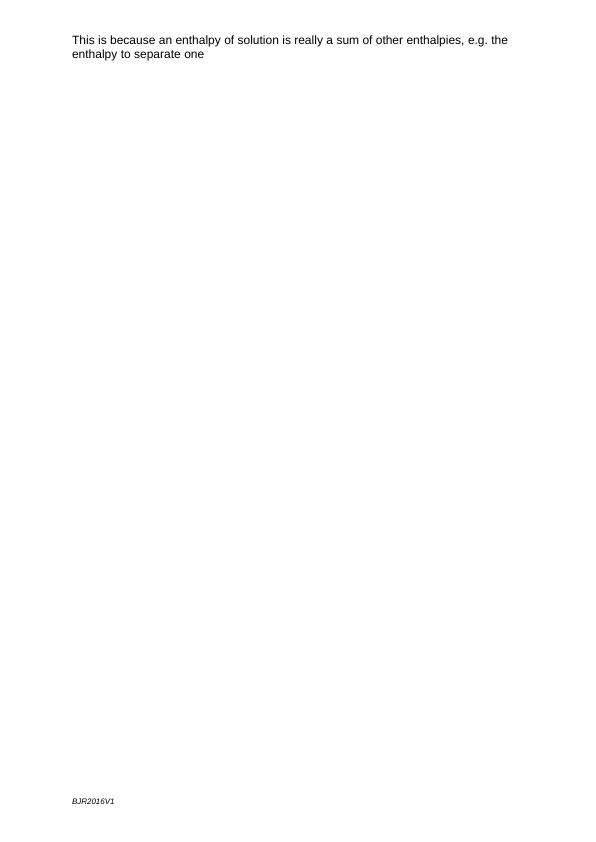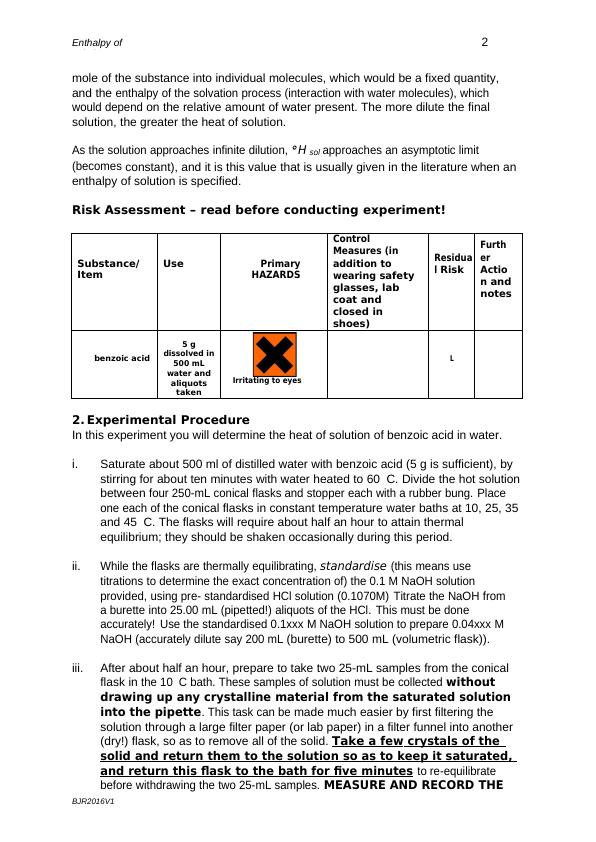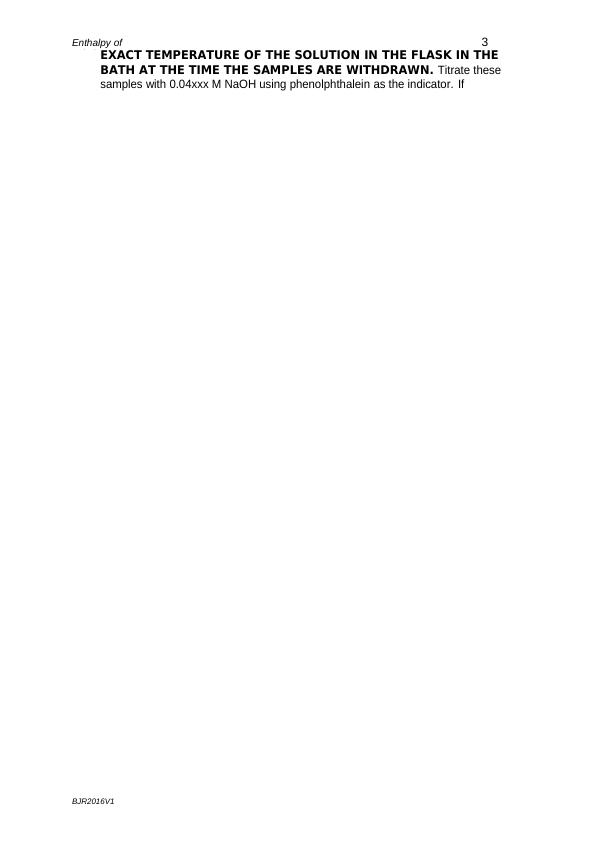Enthalpy of Solution of Benzoic Acid
Added on 2023-01-19
13 Pages3038 Words84 Views
BJR2016V1
so
l
Name................................... Date / /
Partner...................................
Enthalpy of solution of benzoic acid
1. Theory
Most substances exhibit a variation of solubility with temperature. Thermodynamically, this
variation of solubility is described by the van't Hoff equation:
d(ln K ) H
(1)
d(1 /T) R
where K is the equilibrium constant for the dissolution process, T is the absolute
temperature (kelvin) and H
sol is the enthalpy change for the solution process. For a
process such as:
solute(s) ⇌ solute(aq) (2)
where no additional particles (such as ions) are generated, the equilibrium
constant K at a given temperature can be approximated by the
molar (mol kg-1) solubility, b, of the solute (i.e the concentration of a
saturated solution at that temperature). (The relationship between K and b will
be more complex for ionic solutes, and must take into account electrostatic
interactions between ions.)
Substances for which H is positive (i.e. have endothermic heats of solution) will be
more soluble at higher temperatures, since d(ln b)/d(1/T) is negative. Similarly,
compounds that dissolve exothermically, with d(ln b)/d(1/T) positive, are more
soluble at lower temperatures.
Equation 1 can be integrated to give the more useful form:
lnK
H 1
lnb sol
R T constan
t
(3)
This equation can then be used to determine H
sol, by measuring solubility as a
function of temperature and plotting a graph of ln b against 1/T. The slope of the
graph gives a value of
H
sol since:
H
sol = R slope (4)
Molal solubilities (moles of solute / kg of solvent) are used because these are
temperature- independent concentration units: volume of solution varies with
temperature, but mass of solvent does not.
Heats of solution are dependent on the concentration of the dissolved species in
solution. In other words, the heat released (or absorbed) by dissolving one mole of
a solute is not a fixed quantity, unless it is dissolved in an infinite amount of water!
so
l
Name................................... Date / /
Partner...................................
Enthalpy of solution of benzoic acid
1. Theory
Most substances exhibit a variation of solubility with temperature. Thermodynamically, this
variation of solubility is described by the van't Hoff equation:
d(ln K ) H
(1)
d(1 /T) R
where K is the equilibrium constant for the dissolution process, T is the absolute
temperature (kelvin) and H
sol is the enthalpy change for the solution process. For a
process such as:
solute(s) ⇌ solute(aq) (2)
where no additional particles (such as ions) are generated, the equilibrium
constant K at a given temperature can be approximated by the
molar (mol kg-1) solubility, b, of the solute (i.e the concentration of a
saturated solution at that temperature). (The relationship between K and b will
be more complex for ionic solutes, and must take into account electrostatic
interactions between ions.)
Substances for which H is positive (i.e. have endothermic heats of solution) will be
more soluble at higher temperatures, since d(ln b)/d(1/T) is negative. Similarly,
compounds that dissolve exothermically, with d(ln b)/d(1/T) positive, are more
soluble at lower temperatures.
Equation 1 can be integrated to give the more useful form:
lnK
H 1
lnb sol
R T constan
t
(3)
This equation can then be used to determine H
sol, by measuring solubility as a
function of temperature and plotting a graph of ln b against 1/T. The slope of the
graph gives a value of
H
sol since:
H
sol = R slope (4)
Molal solubilities (moles of solute / kg of solvent) are used because these are
temperature- independent concentration units: volume of solution varies with
temperature, but mass of solvent does not.
Heats of solution are dependent on the concentration of the dissolved species in
solution. In other words, the heat released (or absorbed) by dissolving one mole of
a solute is not a fixed quantity, unless it is dissolved in an infinite amount of water!

BJR2016V1
This is because an enthalpy of solution is really a sum of other enthalpies, e.g. the
enthalpy to separate one
This is because an enthalpy of solution is really a sum of other enthalpies, e.g. the
enthalpy to separate one

2Enthalpy of
solution
BJR2016V1
mole of the substance into individual molecules, which would be a fixed quantity,
and the enthalpy of the solvation process (interaction with water molecules), which
would depend on the relative amount of water present. The more dilute the final
solution, the greater the heat of solution.
As the solution approaches infinite dilution, H
sol approaches an asymptotic limit
(becomes constant), and it is this value that is usually given in the literature when an
enthalpy of solution is specified.
Risk Assessment – read before conducting experiment!
Substance/
Item
Use Primary
HAZARDS
Control
Measures (in
addition to
wearing safety
glasses, lab
coat and
closed in
shoes)
Residua
l Risk
Furth
er
Actio
n and
notes
benzoic acid
5 g
dissolved in
500 mL
water and
aliquots
taken
Irritating to eyes
L
2. Experimental Procedure
In this experiment you will determine the heat of solution of benzoic acid in water.
i. Saturate about 500 ml of distilled water with benzoic acid (5 g is sufficient), by
stirring for about ten minutes with water heated to 60 C. Divide the hot solution
between four 250-mL conical flasks and stopper each with a rubber bung. Place
one each of the conical flasks in constant temperature water baths at 10, 25, 35
and 45 C. The flasks will require about half an hour to attain thermal
equilibrium; they should be shaken occasionally during this period.
ii. While the flasks are thermally equilibrating, standardise (this means use
titrations to determine the exact concentration of) the 0.1 M NaOH solution
provided, using pre- standardised HCl solution (0.1070M) Titrate the NaOH from
a burette into 25.00 mL (pipetted!) aliquots of the HCl. This must be done
accurately! Use the standardised 0.1xxx M NaOH solution to prepare 0.04xxx M
NaOH (accurately dilute say 200 mL (burette) to 500 mL (volumetric flask)).
iii. After about half an hour, prepare to take two 25-mL samples from the conical
flask in the 10 C bath. These samples of solution must be collected without
drawing up any crystalline material from the saturated solution
into the pipette. This task can be made much easier by first filtering the
solution through a large filter paper (or lab paper) in a filter funnel into another
(dry!) flask, so as to remove all of the solid. Take a few crystals of the
solid and return them to the solution so as to keep it saturated,
and return this flask to the bath for five minutes to re-equilibrate
before withdrawing the two 25-mL samples. MEASURE AND RECORD THE
solution
BJR2016V1
mole of the substance into individual molecules, which would be a fixed quantity,
and the enthalpy of the solvation process (interaction with water molecules), which
would depend on the relative amount of water present. The more dilute the final
solution, the greater the heat of solution.
As the solution approaches infinite dilution, H
sol approaches an asymptotic limit
(becomes constant), and it is this value that is usually given in the literature when an
enthalpy of solution is specified.
Risk Assessment – read before conducting experiment!
Substance/
Item
Use Primary
HAZARDS
Control
Measures (in
addition to
wearing safety
glasses, lab
coat and
closed in
shoes)
Residua
l Risk
Furth
er
Actio
n and
notes
benzoic acid
5 g
dissolved in
500 mL
water and
aliquots
taken
Irritating to eyes
L
2. Experimental Procedure
In this experiment you will determine the heat of solution of benzoic acid in water.
i. Saturate about 500 ml of distilled water with benzoic acid (5 g is sufficient), by
stirring for about ten minutes with water heated to 60 C. Divide the hot solution
between four 250-mL conical flasks and stopper each with a rubber bung. Place
one each of the conical flasks in constant temperature water baths at 10, 25, 35
and 45 C. The flasks will require about half an hour to attain thermal
equilibrium; they should be shaken occasionally during this period.
ii. While the flasks are thermally equilibrating, standardise (this means use
titrations to determine the exact concentration of) the 0.1 M NaOH solution
provided, using pre- standardised HCl solution (0.1070M) Titrate the NaOH from
a burette into 25.00 mL (pipetted!) aliquots of the HCl. This must be done
accurately! Use the standardised 0.1xxx M NaOH solution to prepare 0.04xxx M
NaOH (accurately dilute say 200 mL (burette) to 500 mL (volumetric flask)).
iii. After about half an hour, prepare to take two 25-mL samples from the conical
flask in the 10 C bath. These samples of solution must be collected without
drawing up any crystalline material from the saturated solution
into the pipette. This task can be made much easier by first filtering the
solution through a large filter paper (or lab paper) in a filter funnel into another
(dry!) flask, so as to remove all of the solid. Take a few crystals of the
solid and return them to the solution so as to keep it saturated,
and return this flask to the bath for five minutes to re-equilibrate
before withdrawing the two 25-mL samples. MEASURE AND RECORD THE

3Enthalpy of
solution
BJR2016V1
EXACT TEMPERATURE OF THE SOLUTION IN THE FLASK IN THE
BATH AT THE TIME THE SAMPLES ARE WITHDRAWN. Titrate these
samples with 0.04xxx M NaOH using phenolphthalein as the indicator. If
solution
BJR2016V1
EXACT TEMPERATURE OF THE SOLUTION IN THE FLASK IN THE
BATH AT THE TIME THE SAMPLES ARE WITHDRAWN. Titrate these
samples with 0.04xxx M NaOH using phenolphthalein as the indicator. If

End of preview
Want to access all the pages? Upload your documents or become a member.
Related Documents
Molarity and Freezing Point Depressionlg...
|3
|648
|64
Heat and Mass Transferlg...
|4
|522
|57
Thermochemical Equation for Combustion of Octane and Bond Enthalpylg...
|6
|1517
|352
Chemistry Study Material: Enthalpy, Dilution, Equilibrium Constant, Spectrometry Experimentlg...
|5
|777
|381
CS5308 WATER AND WASTEWATER ENGINEERINGlg...
|12
|1571
|13
WATER AND WASTEWATER ENGINEERINGlg...
|13
|1393
|18
